stop start PONTIAC VIBE 2007 Owner's Manual
[x] Cancel search | Manufacturer: PONTIAC, Model Year: 2007, Model line: VIBE, Model: PONTIAC VIBE 2007Pages: 432, PDF Size: 2.54 MB
Page 227 of 432
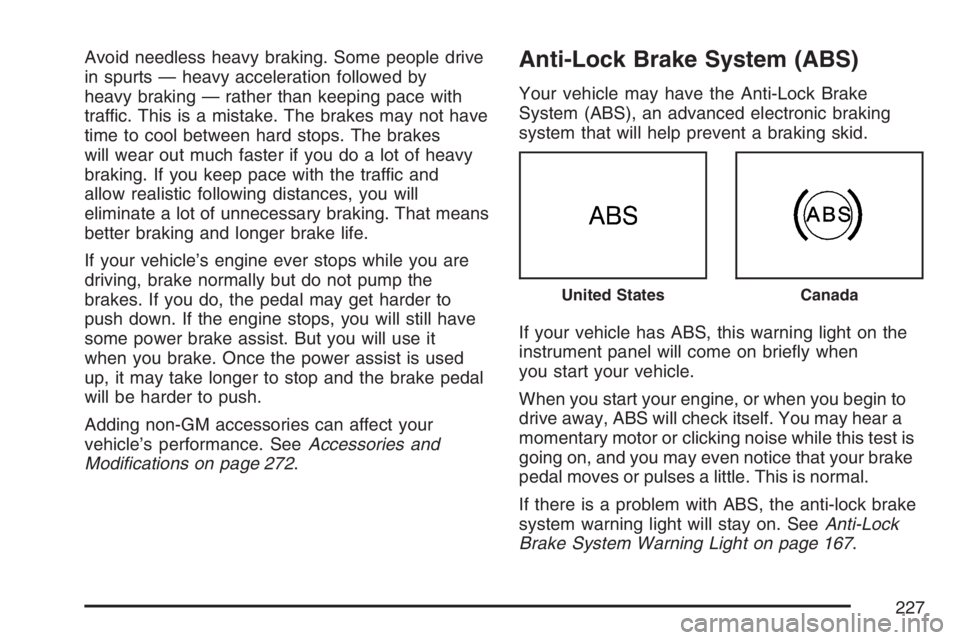
Avoid needless heavy braking. Some people drive
in spurts — heavy acceleration followed by
heavy braking — rather than keeping pace with
traffic. This is a mistake. The brakes may not have
time to cool between hard stops. The brakes
will wear out much faster if you do a lot of heavy
braking. If you keep pace with the traffic and
allow realistic following distances, you will
eliminate a lot of unnecessary braking. That means
better braking and longer brake life.
If your vehicle’s engine ever stops while you are
driving, brake normally but do not pump the
brakes. If you do, the pedal may get harder to
push down. If the engine stops, you will still have
some power brake assist. But you will use it
when you brake. Once the power assist is used
up, it may take longer to stop and the brake pedal
will be harder to push.
Adding non-GM accessories can affect your
vehicle’s performance. SeeAccessories and
Modi�cations on page 272.Anti-Lock Brake System (ABS)
Your vehicle may have the Anti-Lock Brake
System (ABS), an advanced electronic braking
system that will help prevent a braking skid.
If your vehicle has ABS, this warning light on the
instrument panel will come on brie�y when
you start your vehicle.
When you start your engine, or when you begin to
drive away, ABS will check itself. You may hear a
momentary motor or clicking noise while this test is
going on, and you may even notice that your brake
pedal moves or pulses a little. This is normal.
If there is a problem with ABS, the anti-lock brake
system warning light will stay on. SeeAnti-Lock
Brake System Warning Light on page 167.
United StatesCanada
227
Page 231 of 432
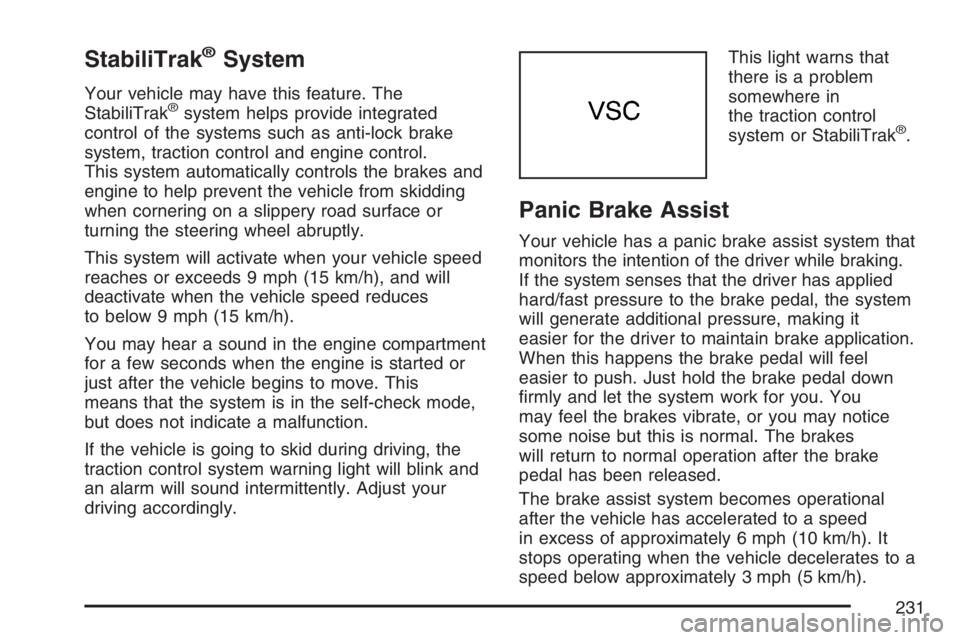
StabiliTrak®System
Your vehicle may have this feature. The
StabiliTrak®system helps provide integrated
control of the systems such as anti-lock brake
system, traction control and engine control.
This system automatically controls the brakes and
engine to help prevent the vehicle from skidding
when cornering on a slippery road surface or
turning the steering wheel abruptly.
This system will activate when your vehicle speed
reaches or exceeds 9 mph (15 km/h), and will
deactivate when the vehicle speed reduces
to below 9 mph (15 km/h).
You may hear a sound in the engine compartment
for a few seconds when the engine is started or
just after the vehicle begins to move. This
means that the system is in the self-check mode,
but does not indicate a malfunction.
If the vehicle is going to skid during driving, the
traction control system warning light will blink and
an alarm will sound intermittently. Adjust your
driving accordingly.This light warns that
there is a problem
somewhere in
the traction control
system or StabiliTrak®.
Panic Brake Assist
Your vehicle has a panic brake assist system that
monitors the intention of the driver while braking.
If the system senses that the driver has applied
hard/fast pressure to the brake pedal, the system
will generate additional pressure, making it
easier for the driver to maintain brake application.
When this happens the brake pedal will feel
easier to push. Just hold the brake pedal down
�rmly and let the system work for you. You
may feel the brakes vibrate, or you may notice
some noise but this is normal. The brakes
will return to normal operation after the brake
pedal has been released.
The brake assist system becomes operational
after the vehicle has accelerated to a speed
in excess of approximately 6 mph (10 km/h). It
stops operating when the vehicle decelerates to a
speed below approximately 3 mph (5 km/h).
231
Page 237 of 432

Loss of Control
Let us review what driving experts say about what
happens when the three control systems — brakes,
steering, and acceleration — do not have enough
friction where the tires meet the road to do what the
driver has asked.
In any emergency, do not give up. Keep trying to
steer and constantly seek an escape route or
area of less danger.
Skidding
In a skid, a driver can lose control of the vehicle.
Defensive drivers avoid most skids by taking
reasonable care suited to existing conditions, and
by not overdriving those conditions. But skids
are always possible.
The three types of skids correspond to your
vehicle’s three control systems. In the braking skid,
your wheels are not rolling. In the steering or
cornering skid, too much speed or steering in a
curve causes tires to slip and lose cornering force.
And in the acceleration skid, too much throttle
causes the driving wheels to spin.A cornering skid and an acceleration skid are best
handled by easing your foot off the accelerator
pedal.
If your vehicle starts to slide, ease your foot off
the accelerator pedal and quickly steer the
way you want the vehicle to go. If you start
steering quickly enough, your vehicle may
straighten out. Always be ready for a second skid
if it occurs.
Of course, traction is reduced when water, snow,
ice, gravel, or other material is on the road.
For safety, you will want to slow down and adjust
your driving to these conditions. It is important
to slow down on slippery surfaces because
stopping distance will be longer and vehicle control
more limited.
While driving on a surface with reduced traction, try
your best to avoid sudden steering, acceleration, or
braking, including reducing vehicle speed by
shifting to a lower gear. Any sudden changes could
cause the tires to slide. You may not realize the
surface is slippery until your vehicle is skidding.
Learn to recognize warning clues — such as
enough water, ice, or packed snow on the road to
make a mirrored surface — and slow down when
you have any doubt.
237
Page 239 of 432
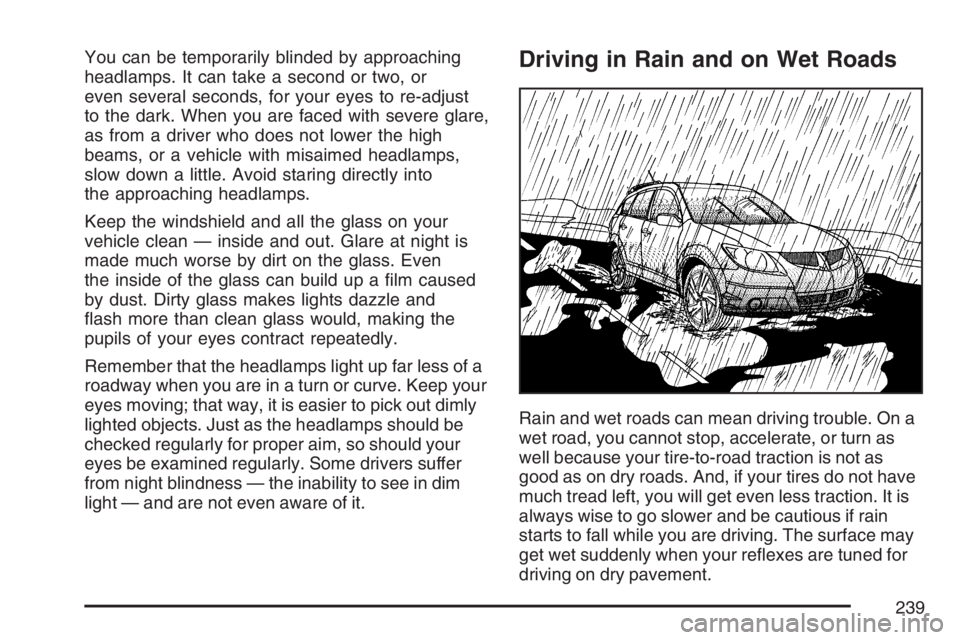
You can be temporarily blinded by approaching
headlamps. It can take a second or two, or
even several seconds, for your eyes to re-adjust
to the dark. When you are faced with severe glare,
as from a driver who does not lower the high
beams, or a vehicle with misaimed headlamps,
slow down a little. Avoid staring directly into
the approaching headlamps.
Keep the windshield and all the glass on your
vehicle clean — inside and out. Glare at night is
made much worse by dirt on the glass. Even
the inside of the glass can build up a �lm caused
by dust. Dirty glass makes lights dazzle and
�ash more than clean glass would, making the
pupils of your eyes contract repeatedly.
Remember that the headlamps light up far less of a
roadway when you are in a turn or curve. Keep your
eyes moving; that way, it is easier to pick out dimly
lighted objects. Just as the headlamps should be
checked regularly for proper aim, so should your
eyes be examined regularly. Some drivers suffer
from night blindness — the inability to see in dim
light — and are not even aware of it.Driving in Rain and on Wet Roads
Rain and wet roads can mean driving trouble. On a
wet road, you cannot stop, accelerate, or turn as
well because your tire-to-road traction is not as
good as on dry roads. And, if your tires do not have
much tread left, you will get even less traction. It is
always wise to go slower and be cautious if rain
starts to fall while you are driving. The surface may
get wet suddenly when your re�exes are tuned for
driving on dry pavement.
239
Page 240 of 432

The heavier the rain, the harder it is to see. Even
if your windshield wiper blades are in good
shape, a heavy rain can make it harder to see
road signs and traffic signals, pavement markings,
the edge of the road, and even people walking.
It is wise to keep your windshield wiping equipment
in good shape and keep your windshield washer
�uid reservoir �lled with washer �uid. Replace your
windshield wiper inserts when they show signs
of streaking or missing areas on the windshield, or
when strips of rubber start to separate from the
inserts.
{CAUTION:
Wet brakes can cause accidents. They
may not work as well in a quick stop and
may cause pulling to one side. You could
lose control of the vehicle.
After driving through a large puddle of
water or a car wash, apply the brake pedal
lightly until the brakes work normally.Driving too fast through large water puddles or
even going through some car washes can cause
problems, too. The water may affect your
brakes. Try to avoid puddles. But if you cannot, try
to slow down before you hit them.
Hydroplaning
Hydroplaning is dangerous. So much water can
build up under your tires that they can actually ride
on the water. This can happen if the road is wet
enough and you are going fast enough. When your
vehicle is hydroplaning, it has little or no contact
with the road.
Hydroplaning does not happen often. But it can if
your tires do not have much tread or if the
pressure in one or more is low. It can happen if a
lot of water is standing on the road. If you can
see re�ections from trees, telephone poles,
or other vehicles, and raindrops dimple the water’s
surface, there could be hydroplaning.
Hydroplaning usually happens at higher speeds.
There just is not a hard and fast rule about
hydroplaning. The best advice is to slow down
when it is raining.
240
Page 244 of 432
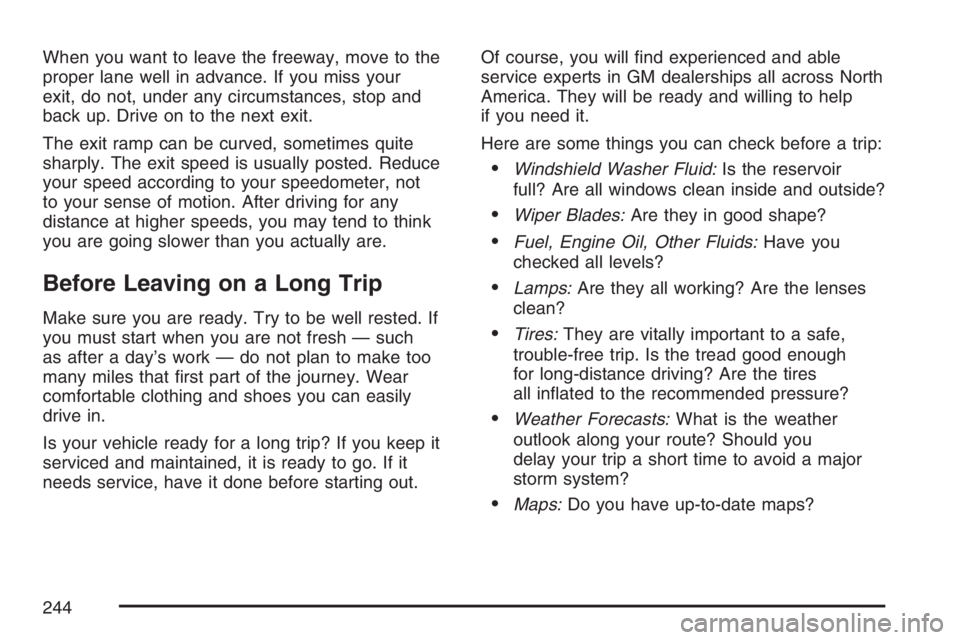
When you want to leave the freeway, move to the
proper lane well in advance. If you miss your
exit, do not, under any circumstances, stop and
back up. Drive on to the next exit.
The exit ramp can be curved, sometimes quite
sharply. The exit speed is usually posted. Reduce
your speed according to your speedometer, not
to your sense of motion. After driving for any
distance at higher speeds, you may tend to think
you are going slower than you actually are.
Before Leaving on a Long Trip
Make sure you are ready. Try to be well rested. If
you must start when you are not fresh — such
as after a day’s work — do not plan to make too
many miles that �rst part of the journey. Wear
comfortable clothing and shoes you can easily
drive in.
Is your vehicle ready for a long trip? If you keep it
serviced and maintained, it is ready to go. If it
needs service, have it done before starting out.Of course, you will �nd experienced and able
service experts in GM dealerships all across North
America. They will be ready and willing to help
if you need it.
Here are some things you can check before a trip:
Windshield Washer Fluid:Is the reservoir
full? Are all windows clean inside and outside?
Wiper Blades:Are they in good shape?
Fuel, Engine Oil, Other Fluids:Have you
checked all levels?
Lamps:Are they all working? Are the lenses
clean?
Tires:They are vitally important to a safe,
trouble-free trip. Is the tread good enough
for long-distance driving? Are the tires
all in�ated to the recommended pressure?
Weather Forecasts:What is the weather
outlook along your route? Should you
delay your trip a short time to avoid a major
storm system?
Maps:Do you have up-to-date maps?
244
Page 268 of 432

When You Are Ready to Leave After
Parking on a Hill
1. Apply your regular brakes and hold the pedal
down while you:
start your engine
shift into a gear, and
release the parking brake
2. Let up on the brake pedal.
3. Drive slowly until the trailer is clear of the
chocks.
4. Stop and have someone pick up and store the
chocks.
Maintenance When Trailer Towing
Your vehicle will need service more often when
you’re pulling a trailer. See the Maintenance
Schedule for more on this. Things that are
especially important in trailer operation are
automatic transaxle �uid (don’t over�ll), engine oil,
drive belt, cooling system and brake system.
Each of these is covered in this manual, and the
Index will help you �nd them quickly. If you’re
trailering, it’s a good idea to review this information
before you start your trip.
Check periodically to see that all hitch nuts and
bolts are tight.
Engine Cooling When Trailer Towing
Your cooling system may temporarily overheat
during severe operating conditions. SeeEngine
Overheating on page 297.
268
Page 269 of 432

Service........................................................ 272
Accessories and Modi�cations................... 272
California Proposition 65 Warning.............. 273
Doing Your Own Service Work.................. 273
Adding Equipment to the Outside of
Your Vehicle.......................................... 274
Fuel............................................................. 274
Gasoline Octane........................................ 274
Gasoline Speci�cations.............................. 274
California Fuel........................................... 275
Additives................................................... 275
Fuels in Foreign Countries........................ 276
Filling the Tank......................................... 277
Filling a Portable Fuel Container............... 279
Checking Things Under the Hood.............. 280
Hood Release........................................... 280
Engine Compartment Overview.................. 282
Engine Oil................................................. 284
Engine Air Cleaner/Filter............................ 288
Automatic Transaxle Fluid......................... 290Manual Transaxle Fluid............................. 292
Hydraulic Clutch........................................ 293
Engine Coolant.......................................... 294
Radiator Pressure Cap.............................. 297
Engine Overheating................................... 297
Cooling System......................................... 299
Power Steering Fluid ................................. 304
Windshield Washer Fluid........................... 305
Brakes...................................................... 306
Battery...................................................... 309
Jump Starting............................................ 310
Bulb Replacement....................................... 315
Halogen Bulbs........................................... 315
Headlamps, Front Turn Signal, and
Parking Lamps....................................... 316
Center High-Mounted
Stoplamp (CHMSL)................................ 317
Taillamps, Turn Signal, and Stoplamps...... 318
Back-Up Lamps......................................... 320
Replacement Bulbs................................... 320
Section 5 Service and Appearance Care
269
Page 366 of 432

Fuses Usage
Empty Not Used
P/W Power Windows
WIPER Windshield Wipers
AM2 Charging System, Air Bag System,
Starter System, Engine Control
STOPStop Lamps, CHMSL, Engine
Control System, Anti-lock Brakes,
Cruise Control
DOOR Power Door Locks, Liftglass Lock
AM1 Cigarette Lighter, Gauge, ECU-IG,
Wiper, Rear Wiper, Washer Fuses
Empty Not Used
ECU-IGCruise Control, Anti-lock Brakes,
Theft Deterrent System, Automatic
Transaxle Control System, Electric
Cooling Fan
RR WIPERRear Window Wiper, Rear
Window Defogger
A/C Air ConditioningFuses Usage
INV Power Outlets
P/POINT Power Outlets
ECU-B Daytime Running Lamps
CIGCigarette Lighter, Power Rearview
Mirrors, Power Outlets, Audio
System, Automatic Transaxle
Control System
GAUGEGauges and Meters, Back-Up
Lamps, Charging System, Power
Door Locks, Power Windows,
Sunroof, Air Conditioning,
Cruise Control
WASHER Windshield Washers
M-HTR/DEF
1–UPEngine Control System
HTR Air Conditioning System
DEFRear Window Defogger,
M-HTR/DEF 1–UP Fuse
POWER Power Windows, Electric Moon Roof
366
Page 430 of 432
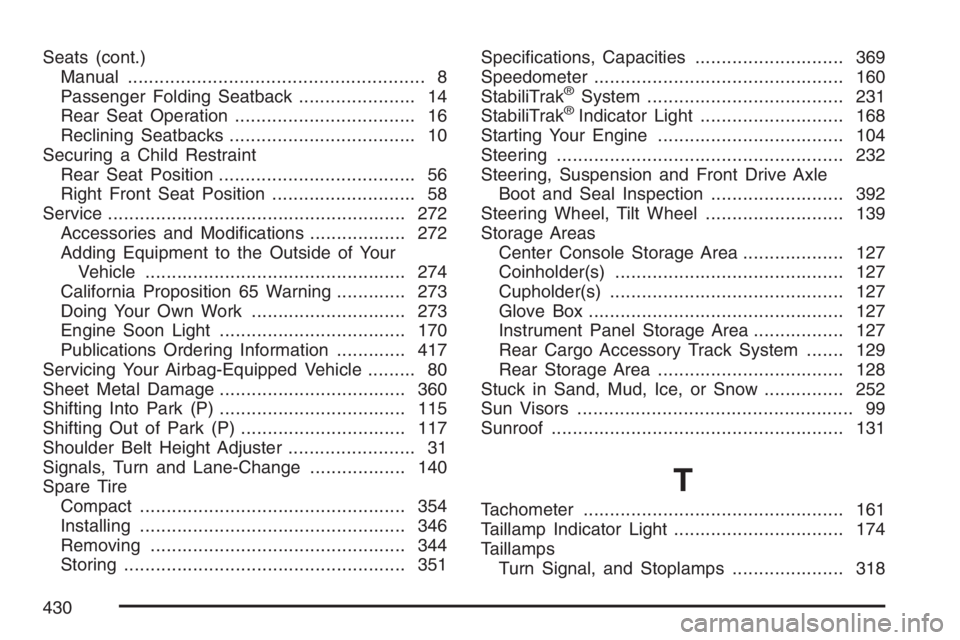
Seats (cont.)
Manual........................................................ 8
Passenger Folding Seatback...................... 14
Rear Seat Operation.................................. 16
Reclining Seatbacks................................... 10
Securing a Child Restraint
Rear Seat Position..................................... 56
Right Front Seat Position........................... 58
Service........................................................ 272
Accessories and Modi�cations.................. 272
Adding Equipment to the Outside of Your
Vehicle................................................. 274
California Proposition 65 Warning............. 273
Doing Your Own Work............................. 273
Engine Soon Light................................... 170
Publications Ordering Information............. 417
Servicing Your Airbag-Equipped Vehicle......... 80
Sheet Metal Damage................................... 360
Shifting Into Park (P)................................... 115
Shifting Out of Park (P)............................... 117
Shoulder Belt Height Adjuster........................ 31
Signals, Turn and Lane-Change.................. 140
Spare Tire
Compact.................................................. 354
Installing.................................................. 346
Removing................................................ 344
Storing..................................................... 351Speci�cations, Capacities............................ 369
Speedometer............................................... 160
StabiliTrak
®System..................................... 231
StabiliTrak®Indicator Light........................... 168
Starting Your Engine................................... 104
Steering...................................................... 232
Steering, Suspension and Front Drive Axle
Boot and Seal Inspection ......................... 392
Steering Wheel, Tilt Wheel.......................... 139
Storage Areas
Center Console Storage Area................... 127
Coinholder(s)........................................... 127
Cupholder(s)............................................ 127
Glove Box................................................ 127
Instrument Panel Storage Area................. 127
Rear Cargo Accessory Track System....... 129
Rear Storage Area................................... 128
Stuck in Sand, Mud, Ice, or Snow............... 252
Sun Visors.................................................... 99
Sunroof....................................................... 131
T
Tachometer................................................. 161
Taillamp Indicator Light................................ 174
Taillamps
Turn Signal, and Stoplamps..................... 318
430